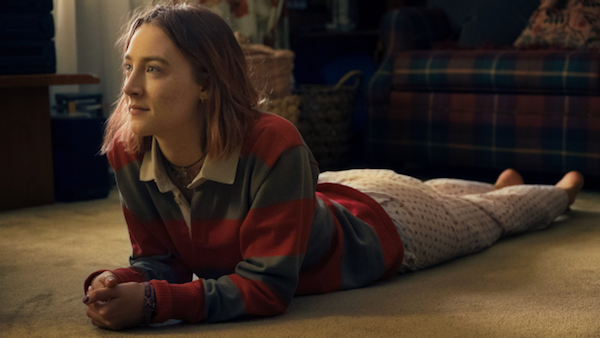Movie review by Greg Carlson
With the critical phenom “Lady Bird,” Greta Gerwig makes good on her stated desire to “offer a female counterpart to tales like ‘The 400 Blows’ and ‘Boyhood.’” A shimmering coming of age chronicle featuring another tremendous performance by Saoirse Ronan, “Lady Bird” is steeped in a kind of nostalgia for the recent past without ever knuckling to the overly familiar. Ronan’s smart, original Christine “Lady Bird” McPherson is an heir to Molly Ringwald’s unforgettable 1980s heroines. And like Andie Walsh and Samantha Baker, Ms. Lady Bird projects that exquisite mixture of sharp-tongued wisdom and frustrated naivete.
You needn’t have been in your teens around the turn of the most recent century to feel the tug of Gerwig’s beautifully realized period piece, but the filmmaker’s visual and audio selections will thrill viewers who acknowledge the lifeforce of the teenage soundtrack. From the drive-in platters of “American Graffiti” to the John Hughes-favored beat of sparkling British pop by OMD, the Psychedelic Furs, and the Smiths, the right song selection can cement the bona fides of a cinematic love letter. In Amanda Petrusich’s “New Yorker” essay “Greta Gerwig Somehow Redeems Dave Matthews Band’s ‘Crash Into Me,’” the author delivers a solid defense of the inclusion — in two key places — of the 1996-1997 song. That track, along with Justin Timberlake and Bone Thugs-n-Harmony, walk the tightrope of ironic kitschiness and earnest affection.
Gerwig’s original, whopping 350-page script existed under the working title “Mothers and Daughters,” and the filmmaker gets tremendous mileage from ideal mom Laurie Metcalf as the tough-love matriarch holding everything together while the rest of her family members struggle to chart a positive course. Metcalf’s Marion McPherson applies her skill as a psychiatric nurse to the delicate homefront issues facing laid-off husband Larry (Tracy Letts) as he struggles to find work. The tug-of-war between Marion and Christine/Lady Bird is at the heart of the film, and conveys the depths of resentment and irritation (and love) between parent and child (Marion: “I just want you to be the very best version of yourself.” Lady Bird: “But what if this is the best version?”).
Reading between the lines of Lady Bird’s anti-Sacramento application essay, the surprisingly forward-thinking Sister Sarah Joan (Lois Smith) recognizes the student’s potential, and will go easy on her following a Bride of Christ prank that most movie nuns would never tolerate (the gung-ho coach recruited to direct the school play is treated much more broadly). Gerwig mostly downplays the private parochial school angle, shifting focus to Lady Bird’s education in romance. Scenes with hot-list actors Lucas Hedges and Timothee Chalamet are highlights, and if Lady Bird wasn’t so utterly and completely captivating in all her other elements, you might wish to see additional interactions with the flawed beaux.
Gerwig launches many of the expected devices of the classic teen film: dual suitors, should-I-stay-or-should-I-go college choices, a mistreated best friend (complete with righteous forgiveness/make-up opportunity totally rocked by the awesome Beanie Feldstein), alcohol-related rites of passage, prom dresses, virginity-loss experience, and so on. The director, however, casts a sympathetic eye on the lot, making “Lady Bird” a sumptuous exercise in personalizing and particularizing the universal.
